7011EHR HRM Strategy: Research Journal Reflecting Course Seminars
VerifiedAdded on 2023/06/08
|18
|4086
|420
Journal and Reflective Writing
AI Summary
This research journal delves into key aspects of Human Resource Management (HRM) strategy, encompassing international HRM, ethics, Corporate Social Responsibility (CSR), and knowledge management. It synthesizes existing literature, exploring dimensions of international HR practices like planning, recruitment, training, and compensation, highlighting the significance of ethnocentric, polycentric, and geocentric approaches. The journal further examines the role of CSR in developing marketing procedures, managing corporate behavior ethically, and contributing to sustainable development. It addresses the integration of CSR with business models and the importance of ethical business practices in a globalized context. Finally, the journal touches upon the relationship between Strategic HRM (SHRM) and knowledge management, emphasizing the role of HR practices in fostering organizational learning and competitive advantage. The analysis concludes with managerial implications, emphasizing the importance of effective training, ethical standards, and socially responsible practices in HRM.

Running head: HRM STRATEGY
HRM strategy
Name of student
Name of University
Author note
Table of Content
HRM strategy
Name of student
Name of University
Author note
Table of Content
Paraphrase This Document
Need a fresh take? Get an instant paraphrase of this document with our AI Paraphraser

1
HRM STRATEGY
s
Part A...............................................................................................................................................2
Abstract........................................................................................................................................2
Synthesis......................................................................................................................................2
Managerial implications...............................................................................................................5
References........................................................................................................................................5
Part B...............................................................................................................................................7
Abstract........................................................................................................................................7
Synthesis......................................................................................................................................7
Managerial implications.............................................................................................................10
References......................................................................................................................................10
Part C.............................................................................................................................................12
Abstract......................................................................................................................................12
Synthesis....................................................................................................................................12
Managerial implications.............................................................................................................15
References......................................................................................................................................15
HRM STRATEGY
s
Part A...............................................................................................................................................2
Abstract........................................................................................................................................2
Synthesis......................................................................................................................................2
Managerial implications...............................................................................................................5
References........................................................................................................................................5
Part B...............................................................................................................................................7
Abstract........................................................................................................................................7
Synthesis......................................................................................................................................7
Managerial implications.............................................................................................................10
References......................................................................................................................................10
Part C.............................................................................................................................................12
Abstract......................................................................................................................................12
Synthesis....................................................................................................................................12
Managerial implications.............................................................................................................15
References......................................................................................................................................15
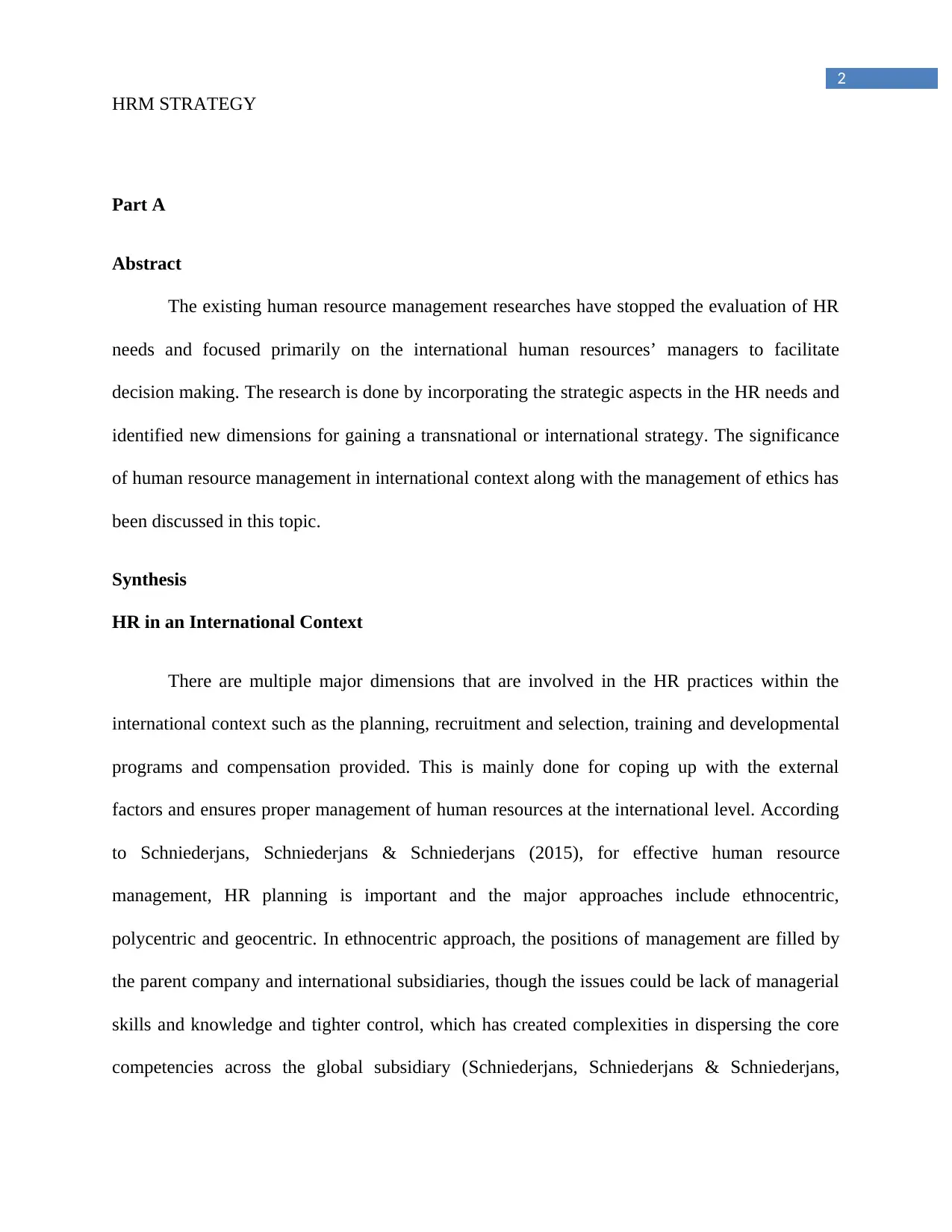
2
HRM STRATEGY
Part A
Abstract
The existing human resource management researches have stopped the evaluation of HR
needs and focused primarily on the international human resources’ managers to facilitate
decision making. The research is done by incorporating the strategic aspects in the HR needs and
identified new dimensions for gaining a transnational or international strategy. The significance
of human resource management in international context along with the management of ethics has
been discussed in this topic.
Synthesis
HR in an International Context
There are multiple major dimensions that are involved in the HR practices within the
international context such as the planning, recruitment and selection, training and developmental
programs and compensation provided. This is mainly done for coping up with the external
factors and ensures proper management of human resources at the international level. According
to Schniederjans, Schniederjans & Schniederjans (2015), for effective human resource
management, HR planning is important and the major approaches include ethnocentric,
polycentric and geocentric. In ethnocentric approach, the positions of management are filled by
the parent company and international subsidiaries, though the issues could be lack of managerial
skills and knowledge and tighter control, which has created complexities in dispersing the core
competencies across the global subsidiary (Schniederjans, Schniederjans & Schniederjans,
HRM STRATEGY
Part A
Abstract
The existing human resource management researches have stopped the evaluation of HR
needs and focused primarily on the international human resources’ managers to facilitate
decision making. The research is done by incorporating the strategic aspects in the HR needs and
identified new dimensions for gaining a transnational or international strategy. The significance
of human resource management in international context along with the management of ethics has
been discussed in this topic.
Synthesis
HR in an International Context
There are multiple major dimensions that are involved in the HR practices within the
international context such as the planning, recruitment and selection, training and developmental
programs and compensation provided. This is mainly done for coping up with the external
factors and ensures proper management of human resources at the international level. According
to Schniederjans, Schniederjans & Schniederjans (2015), for effective human resource
management, HR planning is important and the major approaches include ethnocentric,
polycentric and geocentric. In ethnocentric approach, the positions of management are filled by
the parent company and international subsidiaries, though the issues could be lack of managerial
skills and knowledge and tighter control, which has created complexities in dispersing the core
competencies across the global subsidiary (Schniederjans, Schniederjans & Schniederjans,
⊘ This is a preview!⊘
Do you want full access?
Subscribe today to unlock all pages.

Trusted by 1+ million students worldwide
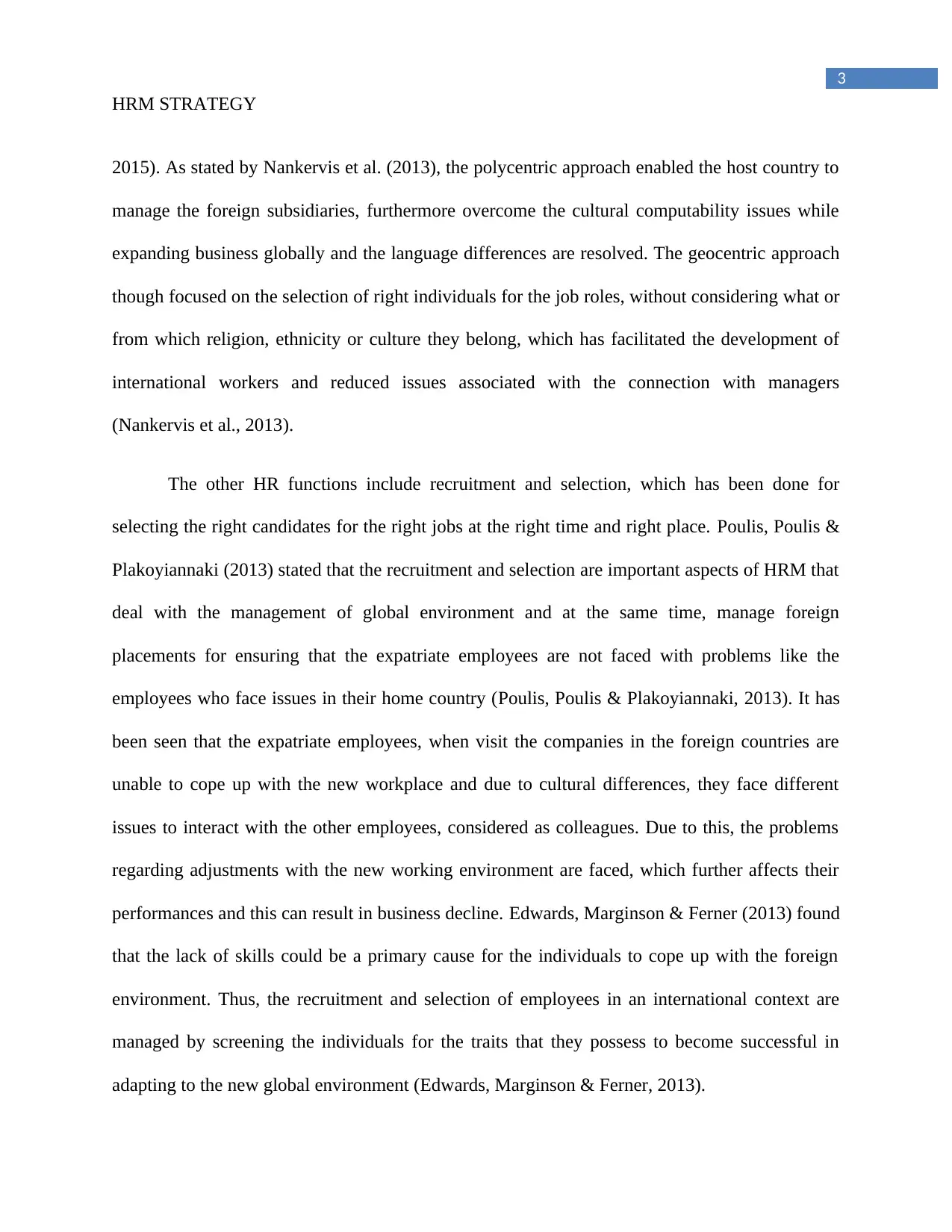
3
HRM STRATEGY
2015). As stated by Nankervis et al. (2013), the polycentric approach enabled the host country to
manage the foreign subsidiaries, furthermore overcome the cultural computability issues while
expanding business globally and the language differences are resolved. The geocentric approach
though focused on the selection of right individuals for the job roles, without considering what or
from which religion, ethnicity or culture they belong, which has facilitated the development of
international workers and reduced issues associated with the connection with managers
(Nankervis et al., 2013).
The other HR functions include recruitment and selection, which has been done for
selecting the right candidates for the right jobs at the right time and right place. Poulis, Poulis &
Plakoyiannaki (2013) stated that the recruitment and selection are important aspects of HRM that
deal with the management of global environment and at the same time, manage foreign
placements for ensuring that the expatriate employees are not faced with problems like the
employees who face issues in their home country (Poulis, Poulis & Plakoyiannaki, 2013). It has
been seen that the expatriate employees, when visit the companies in the foreign countries are
unable to cope up with the new workplace and due to cultural differences, they face different
issues to interact with the other employees, considered as colleagues. Due to this, the problems
regarding adjustments with the new working environment are faced, which further affects their
performances and this can result in business decline. Edwards, Marginson & Ferner (2013) found
that the lack of skills could be a primary cause for the individuals to cope up with the foreign
environment. Thus, the recruitment and selection of employees in an international context are
managed by screening the individuals for the traits that they possess to become successful in
adapting to the new global environment (Edwards, Marginson & Ferner, 2013).
HRM STRATEGY
2015). As stated by Nankervis et al. (2013), the polycentric approach enabled the host country to
manage the foreign subsidiaries, furthermore overcome the cultural computability issues while
expanding business globally and the language differences are resolved. The geocentric approach
though focused on the selection of right individuals for the job roles, without considering what or
from which religion, ethnicity or culture they belong, which has facilitated the development of
international workers and reduced issues associated with the connection with managers
(Nankervis et al., 2013).
The other HR functions include recruitment and selection, which has been done for
selecting the right candidates for the right jobs at the right time and right place. Poulis, Poulis &
Plakoyiannaki (2013) stated that the recruitment and selection are important aspects of HRM that
deal with the management of global environment and at the same time, manage foreign
placements for ensuring that the expatriate employees are not faced with problems like the
employees who face issues in their home country (Poulis, Poulis & Plakoyiannaki, 2013). It has
been seen that the expatriate employees, when visit the companies in the foreign countries are
unable to cope up with the new workplace and due to cultural differences, they face different
issues to interact with the other employees, considered as colleagues. Due to this, the problems
regarding adjustments with the new working environment are faced, which further affects their
performances and this can result in business decline. Edwards, Marginson & Ferner (2013) found
that the lack of skills could be a primary cause for the individuals to cope up with the foreign
environment. Thus, the recruitment and selection of employees in an international context are
managed by screening the individuals for the traits that they possess to become successful in
adapting to the new global environment (Edwards, Marginson & Ferner, 2013).
Paraphrase This Document
Need a fresh take? Get an instant paraphrase of this document with our AI Paraphraser
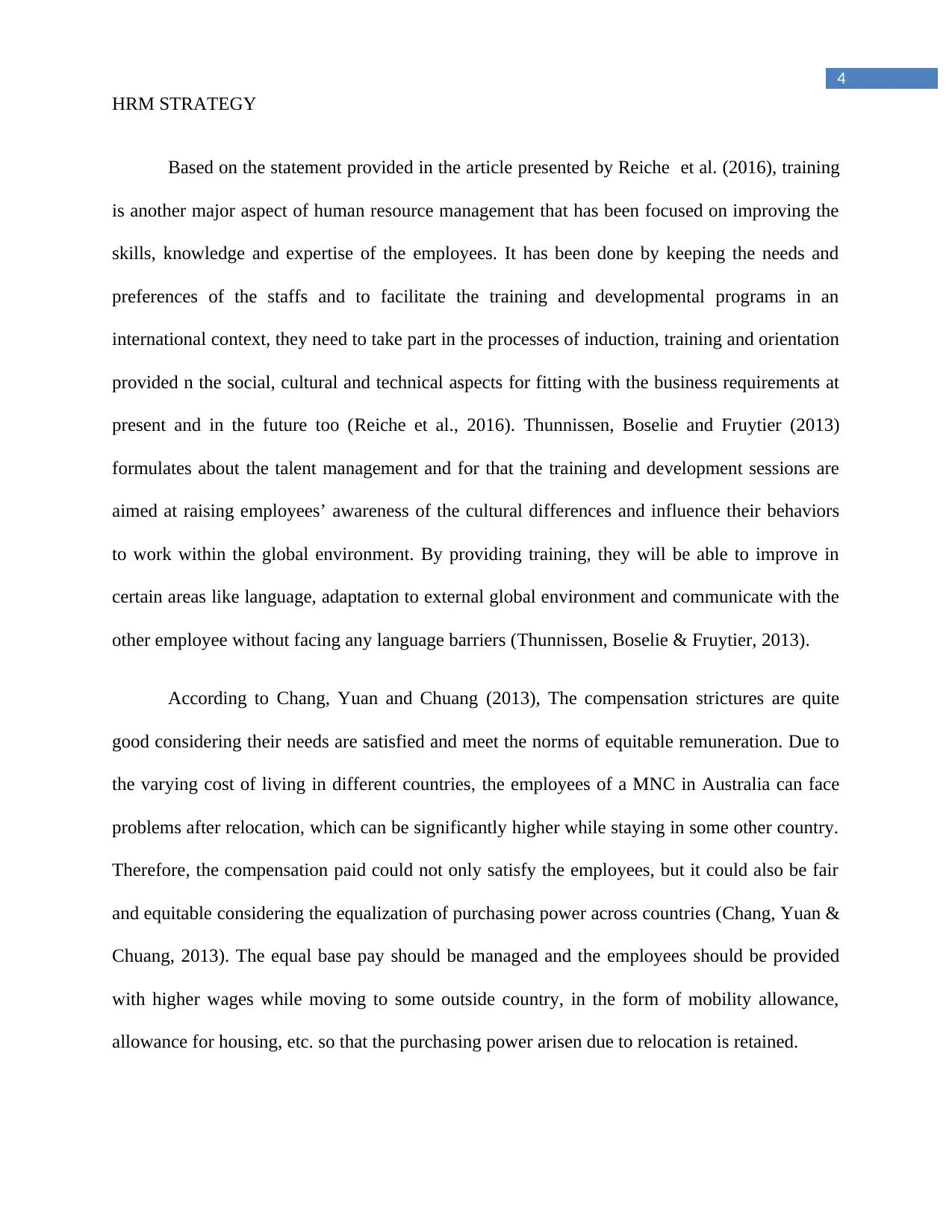
4
HRM STRATEGY
Based on the statement provided in the article presented by Reiche et al. (2016), training
is another major aspect of human resource management that has been focused on improving the
skills, knowledge and expertise of the employees. It has been done by keeping the needs and
preferences of the staffs and to facilitate the training and developmental programs in an
international context, they need to take part in the processes of induction, training and orientation
provided n the social, cultural and technical aspects for fitting with the business requirements at
present and in the future too (Reiche et al., 2016). Thunnissen, Boselie and Fruytier (2013)
formulates about the talent management and for that the training and development sessions are
aimed at raising employees’ awareness of the cultural differences and influence their behaviors
to work within the global environment. By providing training, they will be able to improve in
certain areas like language, adaptation to external global environment and communicate with the
other employee without facing any language barriers (Thunnissen, Boselie & Fruytier, 2013).
According to Chang, Yuan and Chuang (2013), The compensation strictures are quite
good considering their needs are satisfied and meet the norms of equitable remuneration. Due to
the varying cost of living in different countries, the employees of a MNC in Australia can face
problems after relocation, which can be significantly higher while staying in some other country.
Therefore, the compensation paid could not only satisfy the employees, but it could also be fair
and equitable considering the equalization of purchasing power across countries (Chang, Yuan &
Chuang, 2013). The equal base pay should be managed and the employees should be provided
with higher wages while moving to some outside country, in the form of mobility allowance,
allowance for housing, etc. so that the purchasing power arisen due to relocation is retained.
HRM STRATEGY
Based on the statement provided in the article presented by Reiche et al. (2016), training
is another major aspect of human resource management that has been focused on improving the
skills, knowledge and expertise of the employees. It has been done by keeping the needs and
preferences of the staffs and to facilitate the training and developmental programs in an
international context, they need to take part in the processes of induction, training and orientation
provided n the social, cultural and technical aspects for fitting with the business requirements at
present and in the future too (Reiche et al., 2016). Thunnissen, Boselie and Fruytier (2013)
formulates about the talent management and for that the training and development sessions are
aimed at raising employees’ awareness of the cultural differences and influence their behaviors
to work within the global environment. By providing training, they will be able to improve in
certain areas like language, adaptation to external global environment and communicate with the
other employee without facing any language barriers (Thunnissen, Boselie & Fruytier, 2013).
According to Chang, Yuan and Chuang (2013), The compensation strictures are quite
good considering their needs are satisfied and meet the norms of equitable remuneration. Due to
the varying cost of living in different countries, the employees of a MNC in Australia can face
problems after relocation, which can be significantly higher while staying in some other country.
Therefore, the compensation paid could not only satisfy the employees, but it could also be fair
and equitable considering the equalization of purchasing power across countries (Chang, Yuan &
Chuang, 2013). The equal base pay should be managed and the employees should be provided
with higher wages while moving to some outside country, in the form of mobility allowance,
allowance for housing, etc. so that the purchasing power arisen due to relocation is retained.
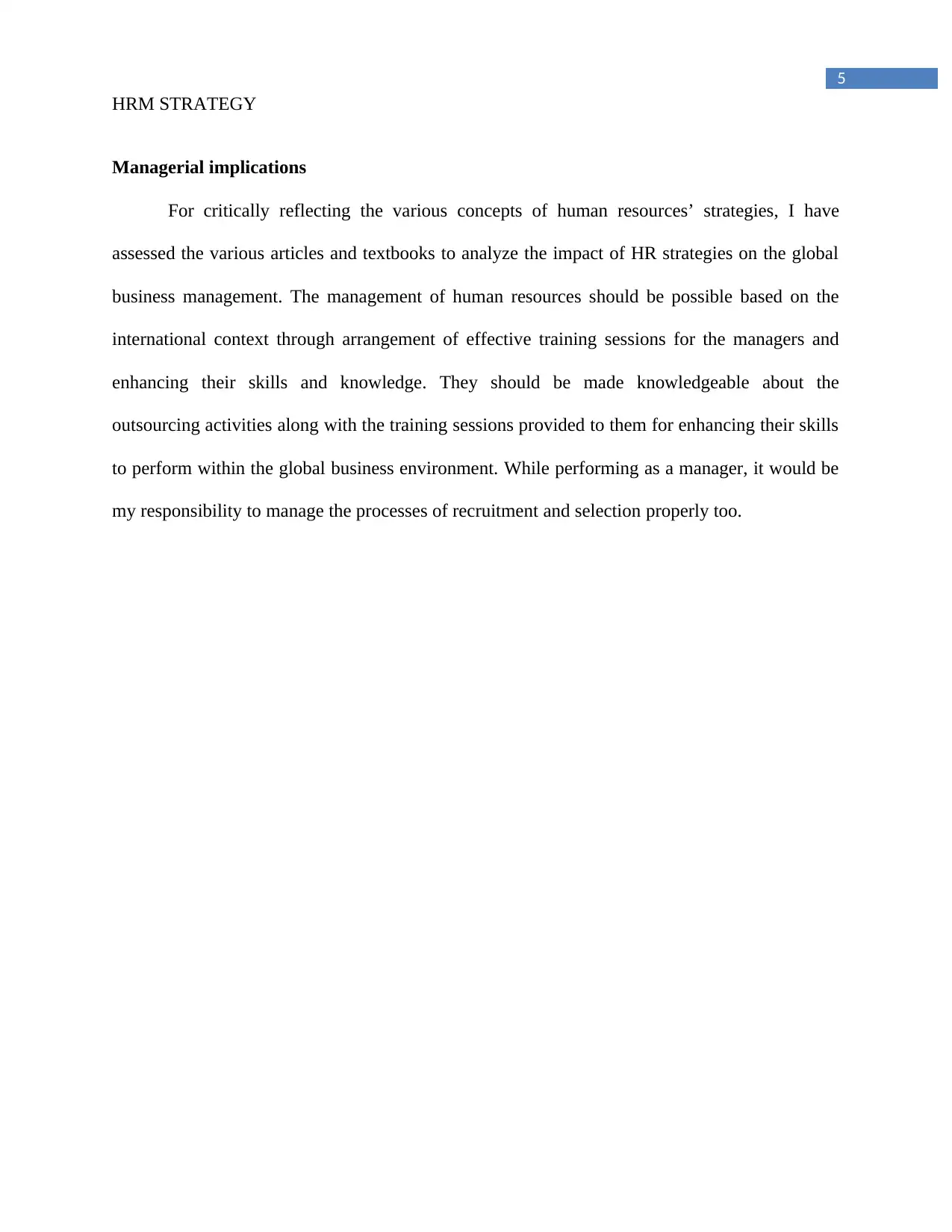
5
HRM STRATEGY
Managerial implications
For critically reflecting the various concepts of human resources’ strategies, I have
assessed the various articles and textbooks to analyze the impact of HR strategies on the global
business management. The management of human resources should be possible based on the
international context through arrangement of effective training sessions for the managers and
enhancing their skills and knowledge. They should be made knowledgeable about the
outsourcing activities along with the training sessions provided to them for enhancing their skills
to perform within the global business environment. While performing as a manager, it would be
my responsibility to manage the processes of recruitment and selection properly too.
HRM STRATEGY
Managerial implications
For critically reflecting the various concepts of human resources’ strategies, I have
assessed the various articles and textbooks to analyze the impact of HR strategies on the global
business management. The management of human resources should be possible based on the
international context through arrangement of effective training sessions for the managers and
enhancing their skills and knowledge. They should be made knowledgeable about the
outsourcing activities along with the training sessions provided to them for enhancing their skills
to perform within the global business environment. While performing as a manager, it would be
my responsibility to manage the processes of recruitment and selection properly too.
⊘ This is a preview!⊘
Do you want full access?
Subscribe today to unlock all pages.

Trusted by 1+ million students worldwide

6
HRM STRATEGY
References
Chang, W. W., Yuan, Y. H., & Chuang, Y. T. (2013). The relationship between international
experience and cross-cultural adaptability. International Journal of Intercultural
Relations, 37(2), 268-273.
Edwards, T., Marginson, P., & Ferner, A. (2013). Multinational Companies in Cross-National
Context: Integration, Differentiation, and the Interactions between MNCS and Nation
States: Introduction to a Special Issue of the ILRReview. ILR Review, 66(3), 547-587.
Nankervis, A. R., Baird, M., Coffey, J., & Shields, J. (2013). Human resource management:
strategy and practice.
Poulis, K., Poulis, E., & Plakoyiannaki, E. (2013). The role of context in case study selection: An
international business perspective. International Business Review, 22(1), 304-314.
Reiche, B. S., Stahl, G. K., Mendenhall, M. E., & Oddou, G. R. (Eds.). (2016). Readings and
cases in international human resource management. Taylor & Francis.
Schniederjans, M. J., Schniederjans, A. M., & Schniederjans, D. G. (2015). Outsourcing and
insourcing in an international context. Routledge.
Thunnissen, M., Boselie, P., & Fruytier, B. (2013). Talent management and the relevance of
context: Towards a pluralistic approach. Human Resource Management Review, 23(4),
326-336.
HRM STRATEGY
References
Chang, W. W., Yuan, Y. H., & Chuang, Y. T. (2013). The relationship between international
experience and cross-cultural adaptability. International Journal of Intercultural
Relations, 37(2), 268-273.
Edwards, T., Marginson, P., & Ferner, A. (2013). Multinational Companies in Cross-National
Context: Integration, Differentiation, and the Interactions between MNCS and Nation
States: Introduction to a Special Issue of the ILRReview. ILR Review, 66(3), 547-587.
Nankervis, A. R., Baird, M., Coffey, J., & Shields, J. (2013). Human resource management:
strategy and practice.
Poulis, K., Poulis, E., & Plakoyiannaki, E. (2013). The role of context in case study selection: An
international business perspective. International Business Review, 22(1), 304-314.
Reiche, B. S., Stahl, G. K., Mendenhall, M. E., & Oddou, G. R. (Eds.). (2016). Readings and
cases in international human resource management. Taylor & Francis.
Schniederjans, M. J., Schniederjans, A. M., & Schniederjans, D. G. (2015). Outsourcing and
insourcing in an international context. Routledge.
Thunnissen, M., Boselie, P., & Fruytier, B. (2013). Talent management and the relevance of
context: Towards a pluralistic approach. Human Resource Management Review, 23(4),
326-336.
Paraphrase This Document
Need a fresh take? Get an instant paraphrase of this document with our AI Paraphraser

7
HRM STRATEGY
Part B
Abstract
The corporate social responsibilities have been managed by the organizations to
contribute to the community and at the same time, improve the quality of environment where
people can live in through sustainable measures. The management of ethics and becoming
socially responsible will not only create a positive brand image, but will also assist in influencing
the business operations considering its positive impact through management of ethics in a
sustainable manner.
Synthesis
Ethics, CSR & Sustainability
According to Idowu et al. (2013), the purpose of corporate social responsibility is to
develop the marketing procedures in the business context considering the significance of
managing corporate behaviors and managing business ethically. The corporate social
responsibilities include management of sustainable strategies and valuing those, furthermore
deploying those in various industries all over Australia to ensure smooth business functioning
(Idowu et al., 2013). The research, development and corporate practices consider the corporate
social responsibility or CSR as major guiding principles responsible for the management of
business success, growth and enhanced profitability. The CSR strategies are implemented by the
businesses for contributing to the sustainable development, furthermore deliver social, economic
and environmental benefits to all the stakeholders involved in business such as the shareholders
or investors, employees, Government and customer. Kolk (2016) incorporated the corporate
social responsibility at the organizational level and considered it as a policy that has been aligned
HRM STRATEGY
Part B
Abstract
The corporate social responsibilities have been managed by the organizations to
contribute to the community and at the same time, improve the quality of environment where
people can live in through sustainable measures. The management of ethics and becoming
socially responsible will not only create a positive brand image, but will also assist in influencing
the business operations considering its positive impact through management of ethics in a
sustainable manner.
Synthesis
Ethics, CSR & Sustainability
According to Idowu et al. (2013), the purpose of corporate social responsibility is to
develop the marketing procedures in the business context considering the significance of
managing corporate behaviors and managing business ethically. The corporate social
responsibilities include management of sustainable strategies and valuing those, furthermore
deploying those in various industries all over Australia to ensure smooth business functioning
(Idowu et al., 2013). The research, development and corporate practices consider the corporate
social responsibility or CSR as major guiding principles responsible for the management of
business success, growth and enhanced profitability. The CSR strategies are implemented by the
businesses for contributing to the sustainable development, furthermore deliver social, economic
and environmental benefits to all the stakeholders involved in business such as the shareholders
or investors, employees, Government and customer. Kolk (2016) incorporated the corporate
social responsibility at the organizational level and considered it as a policy that has been aligned
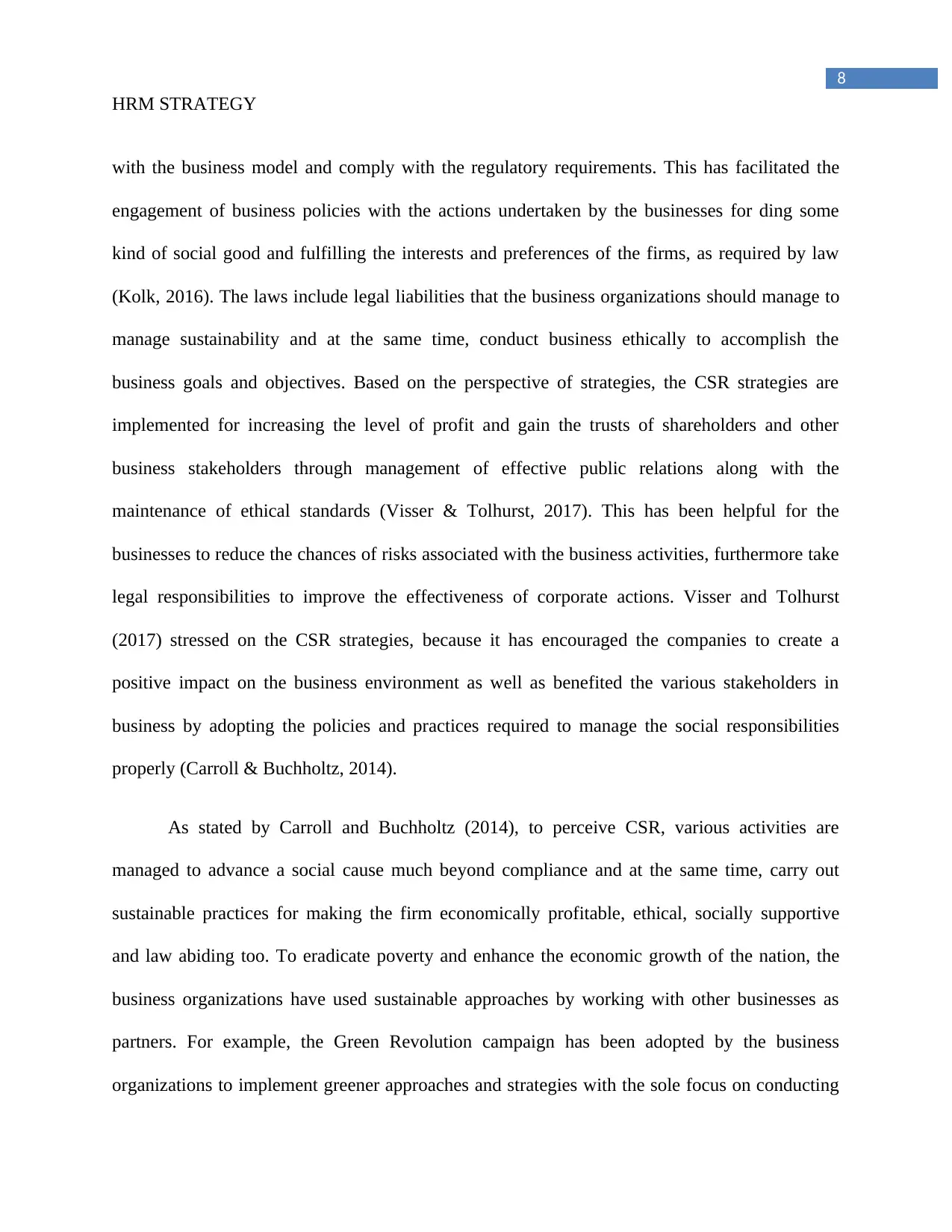
8
HRM STRATEGY
with the business model and comply with the regulatory requirements. This has facilitated the
engagement of business policies with the actions undertaken by the businesses for ding some
kind of social good and fulfilling the interests and preferences of the firms, as required by law
(Kolk, 2016). The laws include legal liabilities that the business organizations should manage to
manage sustainability and at the same time, conduct business ethically to accomplish the
business goals and objectives. Based on the perspective of strategies, the CSR strategies are
implemented for increasing the level of profit and gain the trusts of shareholders and other
business stakeholders through management of effective public relations along with the
maintenance of ethical standards (Visser & Tolhurst, 2017). This has been helpful for the
businesses to reduce the chances of risks associated with the business activities, furthermore take
legal responsibilities to improve the effectiveness of corporate actions. Visser and Tolhurst
(2017) stressed on the CSR strategies, because it has encouraged the companies to create a
positive impact on the business environment as well as benefited the various stakeholders in
business by adopting the policies and practices required to manage the social responsibilities
properly (Carroll & Buchholtz, 2014).
As stated by Carroll and Buchholtz (2014), to perceive CSR, various activities are
managed to advance a social cause much beyond compliance and at the same time, carry out
sustainable practices for making the firm economically profitable, ethical, socially supportive
and law abiding too. To eradicate poverty and enhance the economic growth of the nation, the
business organizations have used sustainable approaches by working with other businesses as
partners. For example, the Green Revolution campaign has been adopted by the business
organizations to implement greener approaches and strategies with the sole focus on conducting
HRM STRATEGY
with the business model and comply with the regulatory requirements. This has facilitated the
engagement of business policies with the actions undertaken by the businesses for ding some
kind of social good and fulfilling the interests and preferences of the firms, as required by law
(Kolk, 2016). The laws include legal liabilities that the business organizations should manage to
manage sustainability and at the same time, conduct business ethically to accomplish the
business goals and objectives. Based on the perspective of strategies, the CSR strategies are
implemented for increasing the level of profit and gain the trusts of shareholders and other
business stakeholders through management of effective public relations along with the
maintenance of ethical standards (Visser & Tolhurst, 2017). This has been helpful for the
businesses to reduce the chances of risks associated with the business activities, furthermore take
legal responsibilities to improve the effectiveness of corporate actions. Visser and Tolhurst
(2017) stressed on the CSR strategies, because it has encouraged the companies to create a
positive impact on the business environment as well as benefited the various stakeholders in
business by adopting the policies and practices required to manage the social responsibilities
properly (Carroll & Buchholtz, 2014).
As stated by Carroll and Buchholtz (2014), to perceive CSR, various activities are
managed to advance a social cause much beyond compliance and at the same time, carry out
sustainable practices for making the firm economically profitable, ethical, socially supportive
and law abiding too. To eradicate poverty and enhance the economic growth of the nation, the
business organizations have used sustainable approaches by working with other businesses as
partners. For example, the Green Revolution campaign has been adopted by the business
organizations to implement greener approaches and strategies with the sole focus on conducting
⊘ This is a preview!⊘
Do you want full access?
Subscribe today to unlock all pages.

Trusted by 1+ million students worldwide
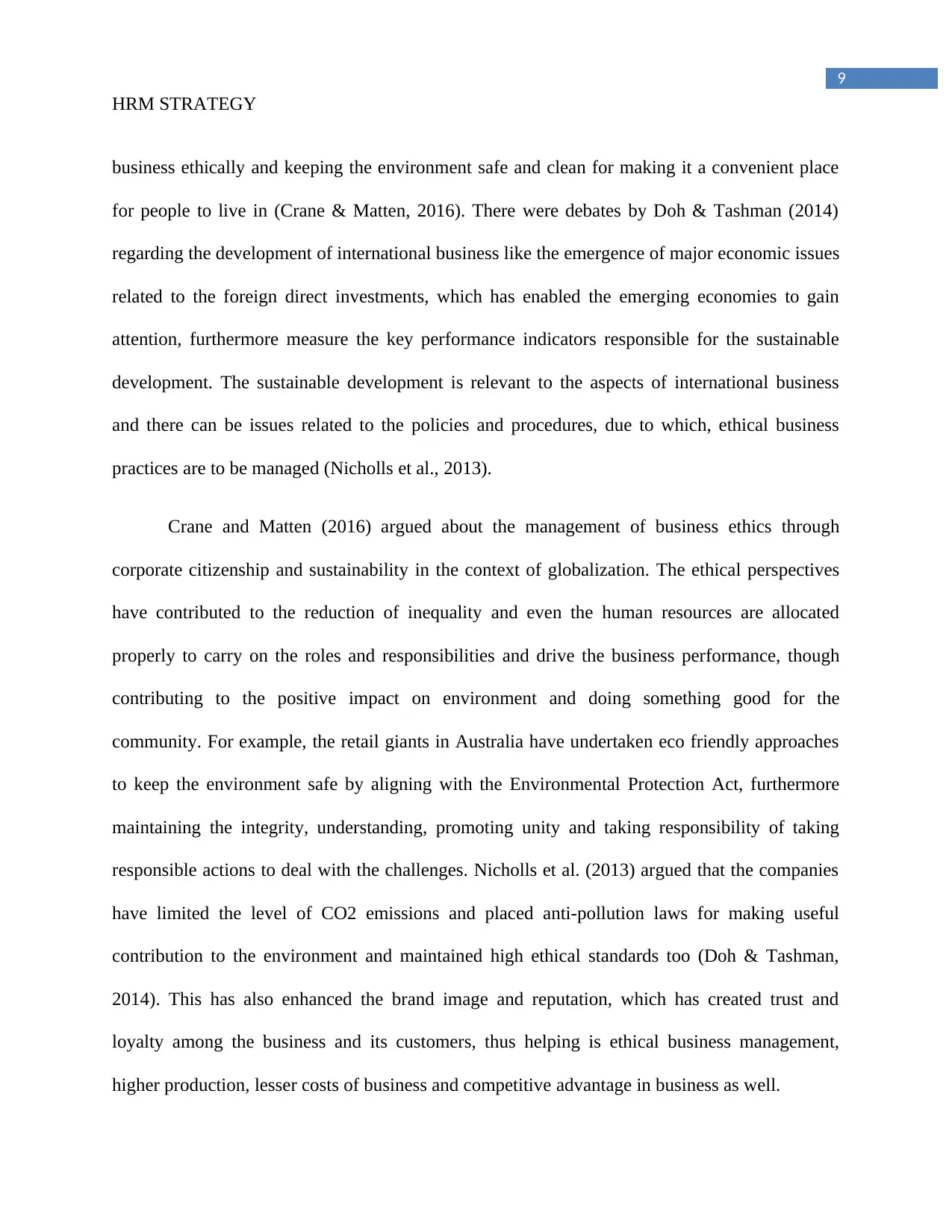
9
HRM STRATEGY
business ethically and keeping the environment safe and clean for making it a convenient place
for people to live in (Crane & Matten, 2016). There were debates by Doh & Tashman (2014)
regarding the development of international business like the emergence of major economic issues
related to the foreign direct investments, which has enabled the emerging economies to gain
attention, furthermore measure the key performance indicators responsible for the sustainable
development. The sustainable development is relevant to the aspects of international business
and there can be issues related to the policies and procedures, due to which, ethical business
practices are to be managed (Nicholls et al., 2013).
Crane and Matten (2016) argued about the management of business ethics through
corporate citizenship and sustainability in the context of globalization. The ethical perspectives
have contributed to the reduction of inequality and even the human resources are allocated
properly to carry on the roles and responsibilities and drive the business performance, though
contributing to the positive impact on environment and doing something good for the
community. For example, the retail giants in Australia have undertaken eco friendly approaches
to keep the environment safe by aligning with the Environmental Protection Act, furthermore
maintaining the integrity, understanding, promoting unity and taking responsibility of taking
responsible actions to deal with the challenges. Nicholls et al. (2013) argued that the companies
have limited the level of CO2 emissions and placed anti-pollution laws for making useful
contribution to the environment and maintained high ethical standards too (Doh & Tashman,
2014). This has also enhanced the brand image and reputation, which has created trust and
loyalty among the business and its customers, thus helping is ethical business management,
higher production, lesser costs of business and competitive advantage in business as well.
HRM STRATEGY
business ethically and keeping the environment safe and clean for making it a convenient place
for people to live in (Crane & Matten, 2016). There were debates by Doh & Tashman (2014)
regarding the development of international business like the emergence of major economic issues
related to the foreign direct investments, which has enabled the emerging economies to gain
attention, furthermore measure the key performance indicators responsible for the sustainable
development. The sustainable development is relevant to the aspects of international business
and there can be issues related to the policies and procedures, due to which, ethical business
practices are to be managed (Nicholls et al., 2013).
Crane and Matten (2016) argued about the management of business ethics through
corporate citizenship and sustainability in the context of globalization. The ethical perspectives
have contributed to the reduction of inequality and even the human resources are allocated
properly to carry on the roles and responsibilities and drive the business performance, though
contributing to the positive impact on environment and doing something good for the
community. For example, the retail giants in Australia have undertaken eco friendly approaches
to keep the environment safe by aligning with the Environmental Protection Act, furthermore
maintaining the integrity, understanding, promoting unity and taking responsibility of taking
responsible actions to deal with the challenges. Nicholls et al. (2013) argued that the companies
have limited the level of CO2 emissions and placed anti-pollution laws for making useful
contribution to the environment and maintained high ethical standards too (Doh & Tashman,
2014). This has also enhanced the brand image and reputation, which has created trust and
loyalty among the business and its customers, thus helping is ethical business management,
higher production, lesser costs of business and competitive advantage in business as well.
Paraphrase This Document
Need a fresh take? Get an instant paraphrase of this document with our AI Paraphraser
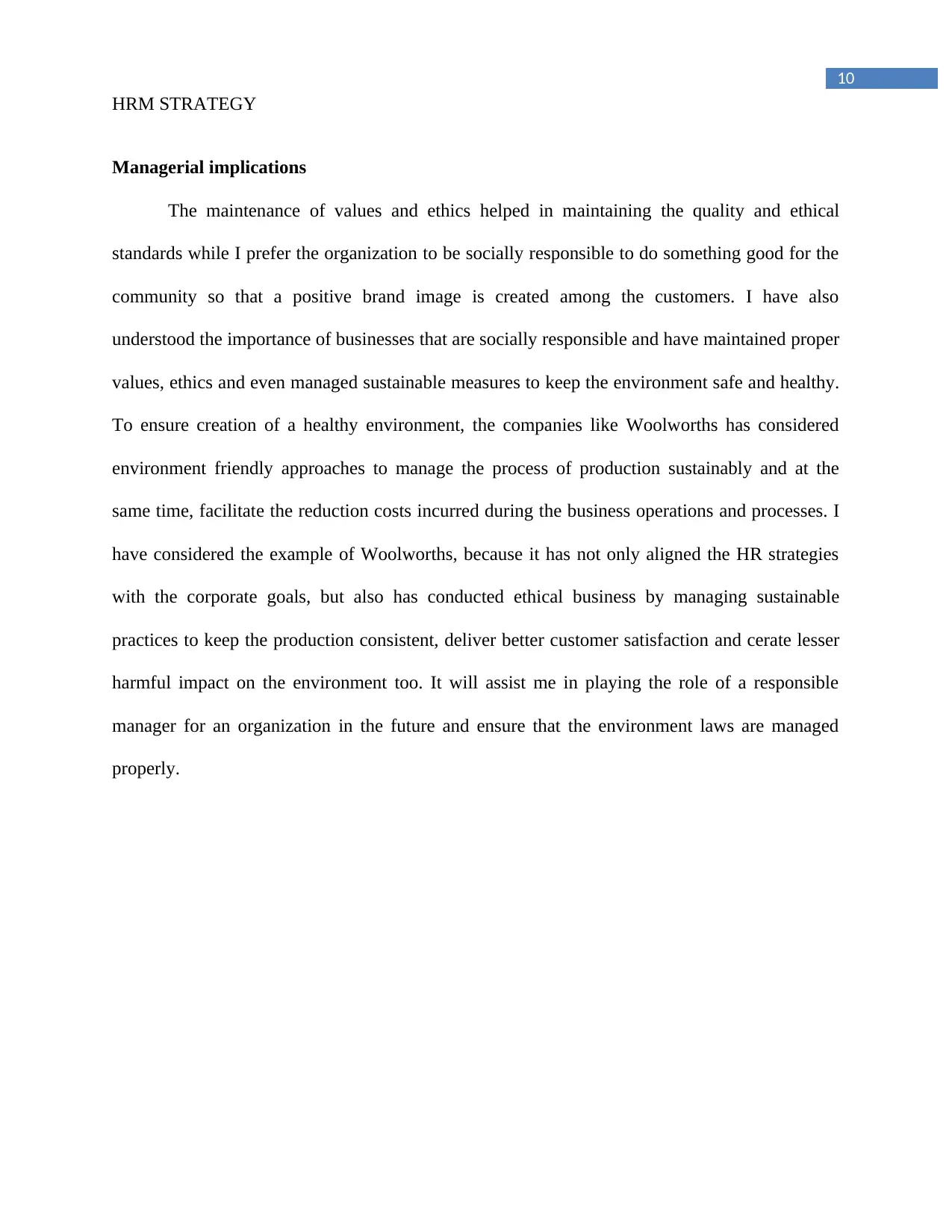
10
HRM STRATEGY
Managerial implications
The maintenance of values and ethics helped in maintaining the quality and ethical
standards while I prefer the organization to be socially responsible to do something good for the
community so that a positive brand image is created among the customers. I have also
understood the importance of businesses that are socially responsible and have maintained proper
values, ethics and even managed sustainable measures to keep the environment safe and healthy.
To ensure creation of a healthy environment, the companies like Woolworths has considered
environment friendly approaches to manage the process of production sustainably and at the
same time, facilitate the reduction costs incurred during the business operations and processes. I
have considered the example of Woolworths, because it has not only aligned the HR strategies
with the corporate goals, but also has conducted ethical business by managing sustainable
practices to keep the production consistent, deliver better customer satisfaction and cerate lesser
harmful impact on the environment too. It will assist me in playing the role of a responsible
manager for an organization in the future and ensure that the environment laws are managed
properly.
HRM STRATEGY
Managerial implications
The maintenance of values and ethics helped in maintaining the quality and ethical
standards while I prefer the organization to be socially responsible to do something good for the
community so that a positive brand image is created among the customers. I have also
understood the importance of businesses that are socially responsible and have maintained proper
values, ethics and even managed sustainable measures to keep the environment safe and healthy.
To ensure creation of a healthy environment, the companies like Woolworths has considered
environment friendly approaches to manage the process of production sustainably and at the
same time, facilitate the reduction costs incurred during the business operations and processes. I
have considered the example of Woolworths, because it has not only aligned the HR strategies
with the corporate goals, but also has conducted ethical business by managing sustainable
practices to keep the production consistent, deliver better customer satisfaction and cerate lesser
harmful impact on the environment too. It will assist me in playing the role of a responsible
manager for an organization in the future and ensure that the environment laws are managed
properly.

11
HRM STRATEGY
References
Carroll, A., & Buchholtz, A. (2014). Business and society: Ethics, sustainability, and stakeholder
management. Nelson Education.
Crane, A., & Matten, D. (2016). Business ethics: Managing corporate citizenship and
sustainability in the age of globalization. Oxford University Press.
Doh, J. P., & Tashman, P. (2014). Half a world away: The integration and assimilation of
corporate social responsibility, sustainability, and sustainable development in business
school curricula. Corporate Social Responsibility and Environmental Management,
21(3), 131-142.
Idowu, S. O., Capaldi, N., Zu, L., & Gupta, A. D. (2013). Encyclopedia of corporate social
responsibility (Vol. 21). New York: Springer.
Kolk, A. (2016). The social responsibility of international business: From ethics and the
environment to CSR and sustainable development. Journal of World Business, 51(1), 23-
34.
Nicholls, J., Hair Jr, J. F., Ragland, C. B., & Schimmel, K. E. (2013). Ethics, corporate social
responsibility, and sustainability education in AACSB undergraduate and graduate
marketing curricula: A benchmark study. Journal of Marketing Education, 35(2), 129-
140.
Visser, W., & Tolhurst, N. (2017). The world guide to CSR: A country-by-country analysis of
corporate sustainability and responsibility. Routledge.
HRM STRATEGY
References
Carroll, A., & Buchholtz, A. (2014). Business and society: Ethics, sustainability, and stakeholder
management. Nelson Education.
Crane, A., & Matten, D. (2016). Business ethics: Managing corporate citizenship and
sustainability in the age of globalization. Oxford University Press.
Doh, J. P., & Tashman, P. (2014). Half a world away: The integration and assimilation of
corporate social responsibility, sustainability, and sustainable development in business
school curricula. Corporate Social Responsibility and Environmental Management,
21(3), 131-142.
Idowu, S. O., Capaldi, N., Zu, L., & Gupta, A. D. (2013). Encyclopedia of corporate social
responsibility (Vol. 21). New York: Springer.
Kolk, A. (2016). The social responsibility of international business: From ethics and the
environment to CSR and sustainable development. Journal of World Business, 51(1), 23-
34.
Nicholls, J., Hair Jr, J. F., Ragland, C. B., & Schimmel, K. E. (2013). Ethics, corporate social
responsibility, and sustainability education in AACSB undergraduate and graduate
marketing curricula: A benchmark study. Journal of Marketing Education, 35(2), 129-
140.
Visser, W., & Tolhurst, N. (2017). The world guide to CSR: A country-by-country analysis of
corporate sustainability and responsibility. Routledge.
⊘ This is a preview!⊘
Do you want full access?
Subscribe today to unlock all pages.

Trusted by 1+ million students worldwide
1 out of 18
Related Documents
Your All-in-One AI-Powered Toolkit for Academic Success.
+13062052269
info@desklib.com
Available 24*7 on WhatsApp / Email
![[object Object]](/_next/static/media/star-bottom.7253800d.svg)
Unlock your academic potential
Copyright © 2020–2025 A2Z Services. All Rights Reserved. Developed and managed by ZUCOL.




